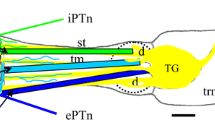Abstract
In Helix aspersa the posterior tentacles house a sensitive olfactory organ. We studied two types of tentacular movements, twitch and quiver. A twitch is a brief retraction (mean duration, 4.1 s); a quiver is a rapid lateral movement (350 ms) unaccompanied by retraction. We videotaped the tentacles while snails explored an open field. When an attractive odor source, linalool, was present at one side of the arena, the snails consistently moved towards it. By contrast, if only the carrier substance was present the snails moved in random directions. Twitching was 50 times more frequent during linalool trials than during control trials, while quivering was 1.4 times more frequent. Twitching increased steadily and dramatically as snails approached the linalool source and, in the temporal dimension, the maximum rate of twitching occurred when the snails arrived at the odor source. Quivers occurred at a fairly constant rate. Twitching is interpreted as a mechanism to remove odor molecules trapped in the liquid covering of the olfactory epithelium, thus resulting in better temporal resolution for olfactory perception. Quivering may be a mechanism to increase access of odor molecules to receptors by decreasing the boundary layer at the surface of the tentacle.
Similar content being viewed by others
Author information
Authors and Affiliations
Additional information
Accepted: 24 May 1997
Rights and permissions
About this article
Cite this article
Lemaire, M., Chase, R. Twitching and quivering of the tentacles during snail olfactory orientation. J Comp Physiol A 182, 81–87 (1997). https://doi.org/10.1007/s003590050160
Issue Date:
DOI: https://doi.org/10.1007/s003590050160




